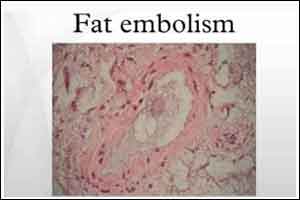- Home
- Editorial
- News
- Practice Guidelines
- Anesthesiology Guidelines
- Cancer Guidelines
- Cardiac Sciences Guidelines
- Critical Care Guidelines
- Dentistry Guidelines
- Dermatology Guidelines
- Diabetes and Endo Guidelines
- Diagnostics Guidelines
- ENT Guidelines
- Featured Practice Guidelines
- Gastroenterology Guidelines
- Geriatrics Guidelines
- Medicine Guidelines
- Nephrology Guidelines
- Neurosciences Guidelines
- Obs and Gynae Guidelines
- Ophthalmology Guidelines
- Orthopaedics Guidelines
- Paediatrics Guidelines
- Psychiatry Guidelines
- Pulmonology Guidelines
- Radiology Guidelines
- Surgery Guidelines
- Urology Guidelines
Woman develops rare life-threatening condition after liposuction

A 45 year old woman developed a serious life threatening condition after having liposuction, reveal doctors in the journal BMJ Case Reports.
The condition, known as fat embolism syndrome (FES), is a rare but very serious complication of liposuction in which fat travels through the body and blocks blood vessels, but it is notoriously difficult to recognise and diagnose.
The authors stress that liposuction is generally a safe procedure, but as its popularity grows, it is important for doctors to consider a diagnosis of FES, especially in patients with underlying risk factors, such as high body mass index (BMI) and fluid retention (lymphoedema).
Shortly after the procedure, the woman became drowsy and confused and had a high heart rate.
Her condition worsened as she was transferred to intensive care where the doctors suspected that she had dangerously low oxygen levels in her body (acute respiratory distress syndrome).
After further tests, the doctors realised that her symptoms pointed to FES.
The woman remained in hospital and was given oxygen and drugs to help with her heart rate and her breathing. She was discharged from hospital after 14 days and on her check up, she had recovered well.
“FES is a difficult condition to initially diagnose,” say the authors. “What makes it even harder is the lack of a standardized set of diagnostic criteria to assist the clinician in making the diagnosis.”
Although still a rare condition, “this article emphasises the importance of thinking outside the box and how to identify and manage such a life-threatening complication,” they conclude.

Disclaimer: This site is primarily intended for healthcare professionals. Any content/information on this website does not replace the advice of medical and/or health professionals and should not be construed as medical/diagnostic advice/endorsement or prescription. Use of this site is subject to our terms of use, privacy policy, advertisement policy. © 2020 Minerva Medical Treatment Pvt Ltd